US History/Truman and Cold War
Bitter Aftermath of Victory
[edit | edit source]Soviet Union
[edit | edit source]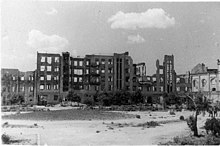
At the end of World War II, the Soviet Union controlled the largest army the world had ever known. Yet the "Mother Country" lay ravaged: nearly one third of its wealth had been destroyed. 32,000 factories were in ruins, 65,000 kilometers (40,000 mi) of railway track were now useless, and an untold number of citizens had been killed. 17,100 townships had been destroyed; 70,000 villages and hamlets had been burned to the ground; 100,000 collective farms had been completely demolished in the military occupation. Citizens who had survived were now starving and resorting to barbaric ways of survival.
After years of struggle with the Wehrmacht, the Soviets were widely regarded as having borne the brunt of destroying Nazism, creating immense respect for the Red Army. "Uncle Joe" Stalin had become a popular figure in Europe and in the United States. Many Europeans thought that having won the war, Stalin could now win the peace.[1]
United States
[edit | edit source]After the war, America's economy was ready to expand into markets on every continent. During the war, much of the world had built up a debt to the United States, and many ex-allies turned towards America for financial relief. Britain negotiated a loan of $3.75 billion. Even the Soviet Union discussed with Washington about the possibility of a $6 billion loan for desperately needed reconstruction.[1]
During the Bretton Woods Conference on the postwar global economy in 1944, the dollar was established as the worlds principal trading currency, while the pound was relegated to second place. Because the dollar was the only currency freely convertible throughout the world, many nations hoped for loans and assistance from the United States. And since the United States was the only power possessing the atom bomb, America seemed to have the advantage in both military and economy when it came to determining the future shape of the world.[1]
During the Cold War the United States opened up many different job opportunities to help out other countries who agreed not to favor communism. This began to become very beneficial to the United States because many countries came to the United States aid to help fight against communism.
President Harry S. Truman
[edit | edit source]
Harry S. Truman had been vice president for only 82 days when President Roosevelt died, on April 12, 1945. He told reporters, "I felt like the moon, the stars, and all the planets had fallen on me." He had had very little communication with Roosevelt about world affairs or domestic politics and was uninformed about major initiatives relating to the war and the top secret Manhattan Project, which was about to test the world's first atomic bomb. Truman was much more difficult for the Secret Service to protect than the wheel chair–bound Roosevelt had been. Truman was an avid walker, regularly taking walks around Washington. Truman was President from April 12, 1945 to January 20, 1953. Deciding not to run again, he retired to his home town of Independence, Missouri.
Truman Doctrine
[edit | edit source]World War II changed the balance of power in the international community by reducing the influence of France and the United Kingdom, while increasing the influence of the United States and the Soviet Union, which became the world's superpowers. The initial sentiments of the US government towards the avowedly socialist Soviet Union were friendly. In the aftermath of the war, however, relations between the two powers quickly deteriorated. At the end of World War II, a number of entities were established by Allied nations to help maintain international order; the most notable of these was the United Nations. Within the framework of the UN, the United States and Britain advocated for the creation of a regulatory entity for the world's monetary system which would help avoid another worldwide depression similar to that seen during the Great Depression before the war. Talks among Allied delegates were held in 1944 which resulted in the creation of the International Monetary Fund and what would eventually become the World Bank, organizations established to make currency exchange easier and to regulate international debt. The Soviet government was highly suspicious of these entities -- it viewed them as a tool for the western world to force capitalism on socialist member-states -- and it refused to support them.
The USSR's refusal to support the IMF and the World Bank set off a diplomatic chain reaction that would eventually grow into what became known as the Cold War.
The Soviet Union believed that its control of Eastern Europe was vital to its security, and said that it was right for it to do so, for "we suffered at Stalingrad". As agreed at the Yalta Conference, the World War II Allies divided Germany into four zones, giving one zone each to the United Kingdom, France, the United States, and the Soviet Union. The Soviet Union's zone, known as East Germany, was later transformed into a Communist state, after an agreement on a unified Germany could not be reached. The other three zones, West Germany, were joined - at first economically through a currency reform - during the implementation of the Marshall Plan in 1948. The city of Berlin, which was surrounded by East Germany, was divided in two parts between East and West Germany. Critics correctly pointed out that the Soviet Union was little involved in the Greek Civil War, that the communists in Greece were more pro-Tito than pro-Stalin, and that the resistance movement had non-communists as well as communist members. Nor was The Soviet Union threatening turkey at the time. Others suggested that such aid should be channeled through the United Nations.
In 1947, Greece became the focus of the Cold War. The Greek monarchy had been supported by Great Britain since 1945. Greek Communists threatened to overthrow this regime, which was corrupt and not representative of the people. In order to "shock" the American public into accepting American involvement in order to help other peoples resist the "communist threat" and secure the strategically and economically important Middle East for US influence, President Harry Truman issued the Truman Doctrine. The Doctrine suggested that the US would aid nations threatened by revolutionary forces. Congress agreed and appropriated $400 million in aid for Greece and Turkey. By 1949, the Communists in Greece were defeated. In 1952, Greece and Turkey entered the NATO.
The Marshall Plan
[edit | edit source]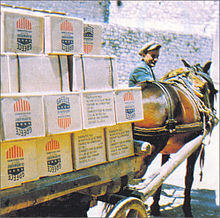
The Marshall Plan was the first attempt to achieve the goals that America set in western Europe. The European nations were still unstable, both in politics and in economics, and so they did not have the money to purchase the good that they required from the U.S. The people and government of America were all extremely worried that if Europe's funds continued to be so unstable, this would trigger another great depression. With the memories of all the hardships and economic ruin of the Great Depression in the 1930s fresh in the American people's minds, the government decided they needed to do something. In order to make sure that there was not another worldwide depression, in 1948 the American government decided to launch a massive European recovery program called the Marshall Plan which sent 12.4 billion dollars to western Europe. A condition of this program was that Europe would spend this foreign-aid money on American products. This program ended in 1951. The Marshall Plan was a mixture of failure and success. In Europe, it assisted to further divide eastern and western Europe and it caused inflation which did nothing to solve the balance-of-payment problem. However, this program did succeed in spurring western European industrialization and investment. [2]
Reconstruction of the New World
[edit | edit source]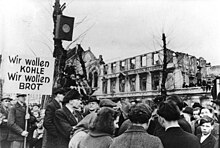
The leadership in the United States by contrast, came out of war extremely confident about the immediate security of the country’s borders. Separated from the other world powers by two vast oceans, the American home base had been virtually immune from attack during the fighting—only the occasional shell from a submarine or a hostile balloon reached the shores of the continental United States American casualties were fewer than those of any other major combatants—hugely so in comparison with the Soviet Union. With its fixed capital intact, its resources more plentiful than ever, and in lone possession of the atomic bomb, the United States was the strongest power in the world at war’s ends.
Yet this was no time for complacency, Washington officials reminded one another. Some other power — almost certainly the USSR — could take advantage of the political and economic instability in war-torn Europe and Asia, and eventually seize control of these areas, with dire implications for America’s physical and economic security. To prevent this eventuality, officials in Washington sought forward bases overseas, in order to keep a airborne enemy at bay. To further enhance U.S. security, American planners, in direct contrast to their Soviet counterparts, sought the quick reconstruction of nations—including the former enemies Germany and Japan—and a world economy based on free trade. Such a system, they reasoned, was essential to preserve America’s economic well being.
The Soviets, on the other hand refused to join the new World Bank and International Monetary Fund, created at the July 1944 Bretton Woods Conference by forty-four nations to stabilize trade and finances. They held that the United States dominated both institutions and used them to promote private investment and open international commerce, which Moscow saw as capitalist tools of exploitation. With the United States as its largest donor, the World Bank opened its doors in 1945 and began to make loans to help members finance reconstruction projects; the IMF, also heavily backed by the united states, helped members meet their balance-of-payment problems through currency loans.
Reconstruction of Japan
[edit | edit source]
After Japan's surrender in 1945, the United States military was directed to reconstruct the nation. American General Douglas MacArthur headed the Reconstruction effort. However, he was aided at every stage by anthropologists and specialists on Japanese history and culture. This effort was not simply an attempt to make the defeated Japanese knuckle under, but a sensitive reconstruction of the whole society for both political modernization and cultural continuity with the pre-Dictatorship history.
MacArthur was dealing with a society in physical and cultural shock. The Japanese Dictatorship had used the Emperor's position as the head of Shinto religion, and his people thought of him as a god. They heard his voice for the first time over the radio announcing their nation's capitulation. Bombing of Japanese infrastructure, and months of shortages, had ruined electrical, water, and sanitary systems. Before Fat Man and Little Boy, an American campaign of bombing Tokyo had killed, wounded, and dismayed civilians. The A-bombs had left areas of Hiroshima and Nagasaki radioactive. Those who had not been killed outright were dying of radiation poisoning and cancer.
In 1947, a new Constitution for Japan was created. The Constitution entirely changed the role of the Emperor from an active leader to a passive symbol of the nation. The Diet, or legislature, was modeled on the British Parliament. The Constitution granted an enormous number of rights to Japanese citizens. Finally, the Constitution formally denounced all military conflict and prohibited Japan from keeping any armed forces.
The Reconstruction of Japan made other sweeping changes. For example, the Reconstruction introduced labor unions and reduced the influence of monopolistic businesses.
During the Cold War, America was determined to make an ally out of the Empire of Japan. The Reconstruction made an about-face, reversing its policy of reducing the power of large businesses. More regulations regarding the economy were made. In 1951, the US agreed to grant Japan full independence and autonomy. The treaty, however, did permit the US to maintain parts of its military in Japan. The treaty became effective in 1952.
The Rise of Communism in China
[edit | edit source]After the fall of the Qing Dynasty, China was in a state of confusion and unrest. The nation saw the worst nightmares as the people were without stable unified authority, fragmenting into a rudderless giant. Many land lords (ward lords, since the standing was imposed and established by force of arms) took advantage of the situation aiming to expand their influence and so fought against each other regardless of common statehood ideas or national purpose and gradually the situation became chaotic. This was the period of warlordism in China, it lasted from 1916 to 1927, a dark period in China’s history.
Meanwhile the principles of communism began to spread in the country and those ideals attracted a majority of the people. The people who belonged to the lower strata were for these principles especially for the law of equality.
The rise of Communism in China is mainly due to a man named Mao Zedong. The son of a farmer, Mao was highly intelligent. Zedong left home for school and had become a member of the Nationalist Army as the Revolution began around 1911. He was soon introduced to and became powerfully influenced by the philosophies of Marxism.
After decades of civil war and invasion by Japan, the communists under Mao prevailed. The opposition nationalists fell and barely managed to retreat offshore to Taiwan. Communism came to power in 1949 under the power of Mao. Communism began as a movement that paved the way for the liberation of the proletariat. Proletariat is that class of society which lives entirely from the sale of its labor and does not draw profit from any kind of capital; whose weal and woe, whose life and death, whose sole existence depends on the demand for labor – hence, on the changing state of business, on the vagaries of unbridled competition. The proletariat, or the class of proletarians, is, in a word, the working class of the 19th century.
Anarchy was to some extend controlled by Mao but he faced failure many times. Mao’s initiatives did cause a kind of equality to emerge in China, but it was not one in which all the inhabitants of China benefited. Contrarily, many of them suffered extreme poverty and greatness was lost in the realms of academia, science, and technology which hindered China’s ability to become a modern nation capable of interacting on the global scale.
The Red Scare and McCarthyism
[edit | edit source]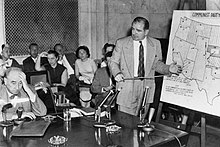
When China fell to Communism, suspicion of the ideology's influence in the American government became a pandemic. Many experts on China and the regions around it were fired as in some way causing the change. This became a problem during the Korean War. What became known as the Red Scare proved costly in American life.
Congress passed the McCarran Internal Security Act in 1950, overriding President Truman's veto. The Act created a public body known as the Subversive Activities Control Board; the Board was charged with monitoring and investigating Communist Activities.
In Congress, meanwhile, Wisconsin Senator Joseph McCarthy accused certain government officials of being Communists and disloyal. While a Communist conspiracy involving State Department employees was eventually uncovered, many of the accusations were baseless. The word McCarthyism refers to a vindictive persecution of the innocent.
Documents from the Venona counterintelligence project suggest that a few targets of McCarthyism were indeed working with the Soviet Union. Historians continue to debate this topic.
The House of Representatives had established a Committee on Un-American Activities in 1947. The Committee performed actions such as investigating actors, directors, and writers. As was the case with Red Summer, it was not mere membership in the Communist party which caused suspicion. Individuals were sometimes grilled for belonging to the National Association for the Advancement of Colored People or the American Civil Liberties Union. It was not enough to confess innocence: you had in turn to accuse others of Communism. A few in the dragnet had actually been Communists, either because they had actually believed in its aims or as part of the polarization of American society in the era of the Spanish Civil War.
However, the opponents of the Committee were not all Communist. Some accused it of violating the Constitutional rights against self-incrimination and for freedom of belief. The entertainment industry, fearful of an investigation, fired many people who had become shadowed by the hearings, or by a pamphlet called "Red Channels." Men and women lost their livelihood, in some cases fleeing to Europe and elsewhere, in others even committing suicide over their lost lives. Ten individuals refused to name names, including screenwriters Dalton Trumbo and Ring Lardner, Jr., and were all duly blacklisted as the Hollywood Ten.
Some local communities banned literature that they feared would encourage Communism. Public servants and teachers were forced to take a so-called "loyalty oath": those who refused, for whatever reason, were not hired. Others lost their jobs due to unfounded accusations of disloyalty. FBI director J. Edgar Hoover, who had come to power in the wake of the first Communist scare, had Americans followed on suspicion of Communism. Scientist J. Robert Oppenheimer, who had helped develop the atomic bomb, was fired from his high-security job because of his former associations with the Communist party. Yet the career of Joseph McCarthy was also derailed during the Red Scare: in 1954, the Senate formally censured him for abusing his powers and using unfair tactics in targeting innocent government officials.
Even at the height of the McCarthyist furor in the early 1950s, the anti-Communist crusade was relatively mild. Many prosecutions faltered on appeal and only a few foreign-born radicals were actually deported. Only Julius and Ethel Rosenberg were put to death. Of the roughly 150 people who went to prison, most were released within a year or two. Yet the after effects lasted for decades. When the United States later fought a war in Vietnam, it was often in the dark because a number of regional experts had been lost to the Red Scare.
The Korean War
[edit | edit source]Background
[edit | edit source]After World War II, the US attempted to curb Soviet influence on the Korean Peninsula by occupying southern part of that area. The area occupied by the US became South Korea, while the other part became North Korea. North Korea soon passed into the control of the Communist Party.
North Korean Offensive
[edit | edit source]
In May, 1949, fighting between North and South Korean troops broke out near the border between the two nations. In an attempt to add South Korea to the Communist World, North Korea invaded South Korea in 1950. The People's Republic of China and the Soviet Union lent their support to North Korea, while the United States did the same to South Korea. On June 25, 1950 a large military force moved across the 38th parallel in the Republic of Korea. Since 1910, Korea had been divided into two by the powers of Japans victory in 1945. The Korean war was seen as an internal struggle, with the north heavily armed and backed by China and the Soviet Union invading the lightly armed south. The two parts moved along the temporary border while the anti-government fighting began to flare into the south.
On June 27, 1950 the United Nations security Council first adopted a ceasefire resolution. When the United Nations Security Council voted to aid South Korea in stopping North Korean aggression, the United States agreed to send troops to the Korean Peninsula. General Douglas MacArthur was given the command of UN troops in Korea. The United States agreed to send troops over on June 30 along with increasing aid to the French fight against Communists rebels in Indochina. MacArthur was placed in command on July 8. At the beginning the U.S. troops were lacking training and were out of shape. In the first few weeks of fighting the U.S. troops were pushed back to a defensive perimeter at Pusan.[3]
Back and Fourth
[edit | edit source]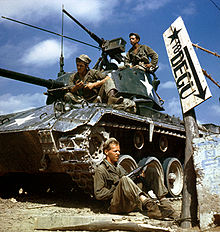
By the autumn of 1950, North Korean troops were forced out of South Korea. In October, General MacArthur ordered troops to cross into North Korea. In the third week of that month, the US took the capital of North Korea, Pyongyang.
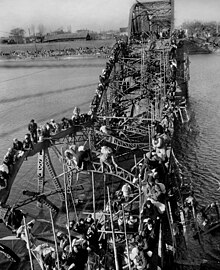
However, just six days after the United Nations forces took Pyongyang, the People's Republic of China sent a quarter million men on a series of counterattacks. In December, Chinese "volunteers" took over Pyongyang and by January 1951 they had taken the South Korean capital, Seoul.
The US intended to do whatever it took to win the Korean War. It even planned on using the atomic bomb. However, President Truman did not trust General MacArthur to follow orders when using the atomic bomb. Therefore, he asked for MacArthur's resignation; MacArthur complied.
Stalemate
[edit | edit source]In 1953, Dwight D. Eisenhower became President of the US. Having promised during the election campaign to end the Korean War, he fulfilled this promise by continuing negotiations with the North and South Koreans, Chinese, and the Soviet Union and using "brinkmanship" to reach an agreement acceptable to all countries involved except for South Korea, which tried to induce the US to help unite Korea.
Weapons of the Cold War
[edit | edit source]Nuclear Weapons
[edit | edit source]
The nuclear arms race was central to the Cold War. Many feared where the Cold War was going with the belief that the more nuclear weapons you had, the more powerful you were. Both America and The Soviet Union massively built up their stockpiles of nuclear weapons.
The world greatly changed when USA exploded the H-bomb in 1952. This one bomb was smaller in size than the Hiroshima atomic bomb but 2500 times more powerful. The Soviets produced an H-bomb in 1953 and the world became a much more dangerous place.
Nuclear Triad
[edit | edit source]
The Cold War also saw innovation in delivery platforms. By using land based, sea based, and air based weapons platforms, a Nuclear triad could be established. This made it difficult to ensure all of a nations nuclear weaponry could be destroyed in a surprise first strike.
Deterrence
[edit | edit source]By April of 1950 the US Department of State had concluded that the Soviet Union was a significant hostile threat, and through it's NSC-68 report advocated that deterrence through an arms build up would be the best way to counter that threat.[4] By building up a number of weapons, it was hoped that the Soviet Union would be detered from waging a nuclear war.
USA produced a bomber - the B52 - that could fly 6,000 miles and deliver a nuclear pay-load. Such a development required massive financial backing from the government - something which America could afford to do and which The Soviet Union could not. The Soviet Union concentrated on producing bigger bombs - a far more cost effective procedure.
In October 1957, the world was introduced to the fear of a missile attack when the Soviet Satellite Sputnik was launched. This was to lead to ICBM’s : Inter-continental ballistic missiles. As a result, America built the DEW line around the Arctic - Distant Early Warning system.
At the end of the 1950’s, American Intelligence estimated that in a Soviet missile attack, 20 million Americans would die and 22 million would be injured.
During the 1960’s, the Soviet's put their money into producing larger missiles, Eventually creating Tsar Bomba, the biggest Nuclear Weapon ever created. America built fewer but technologically superior missiles - the Atlas could go 5,000 miles at a speed of 16,000 mph. By 1961, there were enough bombs to destroy the world.
Despite this, great emphasis was put on new weapon systems - mobile missile launchers were built, missiles were housed underground in silos and in 1960 the first Polaris submarine was launched carrying 16 nuclear missiles. Each missile carried four warheads which could targeted on different cities; hence one submarine effectively carried 64 nuclear warheads.
During the 1960’s the theory of MAD developed - Mutually Assured Destruction. This meant that if The Soviet Union attacked the west, the west would make sure that they would suitably retaliate i.e. there would be no winners.

By 1981, USA had 8,000 ICBMs and USSR 7,000 ICBMs
By 1981, USA had 4,000 planes capable of delivering a nuclear bomb. the USSR had 5000.
USA defense spending for 1981 = 178 billion dollars. By 1986, it was 367 billion dollars.
By 1986, it is estimated that throughout the world there were 40,000 nuclear warheads - the equivalent of one million Hiroshima bombs.
British Intelligence estimated that just one medium sized H-bomb on London would essentially destroy anything living up to 30 miles away.
Confronted by such awesome statistics, world leaders had to move to a position where they trusted each other more. Throughout the 1960's and 1970's "detente" had been used to ease bad relations between the superpowers. This was to culminate in the Reykjavik meeting between presidents Reagan and Gorbachev that started real progress in the cut in nuclear weaponry in future meetings (if little was actually gained at the meeting in Reykjavik).
References
[edit | edit source]- ↑ a b c Isaacs, Jeremy, Taylor Downing, Markus Schurr, Heike Schlatterer, and Norbert Juraschitz. DerKalte Krieg: Ein Illustrierte Geschichte, 1945-1991. Mu%u0308nchen, etc.: Diana Verlag, 1999. Print.
- ↑ A People and A Nation Eighth Edition
- ↑ "Don't Know Much About History" by Kenneth C. Davis
- ↑ "Milestones: 1945–1952 - Office of the Historian". history.state.gov. Retrieved 23 October 2021.